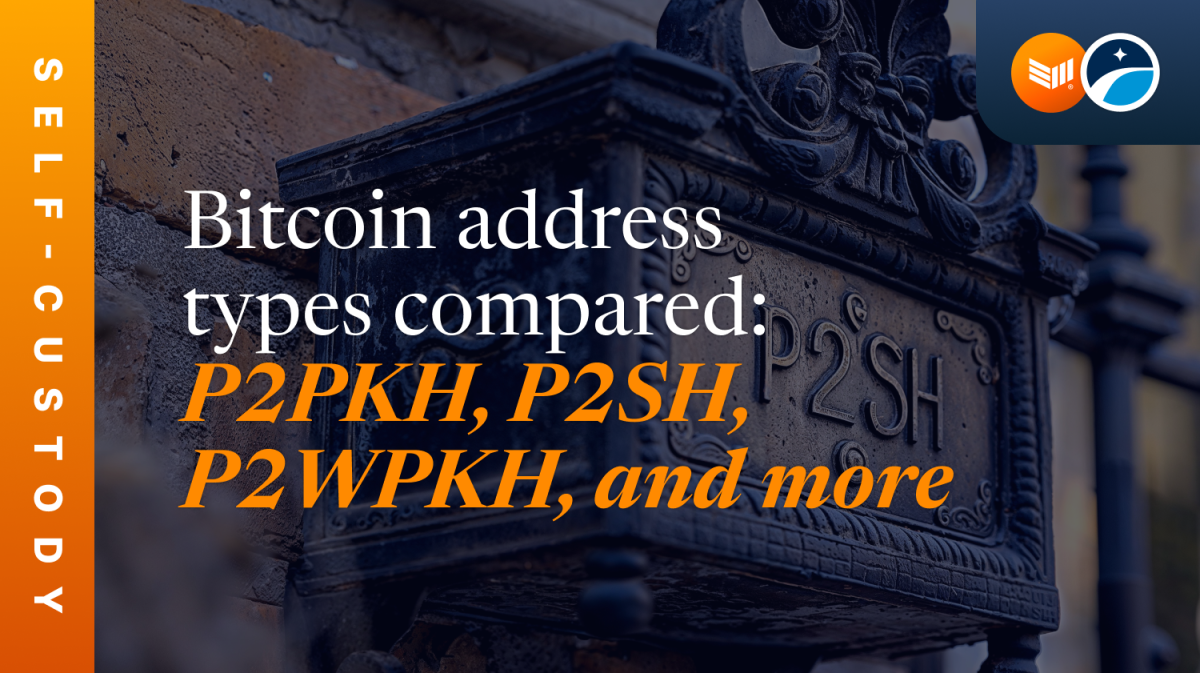Month: April 2024
Asia FX sees some relief as dollar retreats, yen at 34-year lows
Post Content
Bitcoin address types compared: P2PKH, P2SH, P2WPKH, and more
Originally published on Unchained.com.
Unchained is the official US Collaborative Custody partner of Bitcoin Magazine and an integral sponsor of related content published through Bitcoin Magazine. For more information on services offered, custody products, and the relationship between Unchained and Bitcoin Magazine, please visit our website.
If you’ve been using bitcoin for a while, you’ve probably noticed that some bitcoin addresses appear quite different from others. You may have also seen discussion around several acronyms beginning with “P2,” such as P2PKH or P2WSH. If you’re unfamiliar with what these acronyms mean, here we’ll look through all the standardized on-chain methods for receiving bitcoin throughout its history and explain some essential differences that make each method unique.
P2PK
Pay-to-Public-Key (P2PK) is the original method of receiving bitcoin, and it does not involve an address. Instead, as the name suggests, bitcoin is paid directly to an exposed public key. The first ever bitcoin transaction from one person to another used P2PK, when Satoshi Nakamoto sent coins to Hal Finney in Block 170.
P2PK is no longer used because it is a more expensive, less private, and less secure way of receiving bitcoin than subsequent methods.
Quick facts
P2PKH
Pay-to-Public-Key-Hash (P2PKH) was available for use at bitcoin’s beginning, and it showed up on the blockchain for the first time less than two weeks after the genesis block. P2PKH makes several improvements upon P2PK, such as utilizing an address. As discussed in our earlier article, addresses contain a checksum that helps prevent typos and lost bitcoin.
P2PKH addresses are typically 34 or 33 characters in length (but could theoretically be as short as 26 characters), and they are encoded in Base58 format. They begin with a prefix of 1 and are currently responsible for receiving and securing 43% of the mined bitcoin supply, more than any other address type.
Upgrade your Bitcoin security and get access to exclusive discounts on Unchained financial services. Visit our website to learn more.
Creating a P2PKH address involves putting a single public key through hash functions SHA-256 and RIPEMD-160. This shortens the amount of data, which in turn helps save block space and transaction fees for the user. It also introduces further resistance to reverse-engineering the private key beyond the already believed-to-be-unbreakable secp256k1 elliptic curve.
Quick facts
P2MS
Pay-to-Multisig (P2MS) is a trivial transaction type that was only briefly relevant and has never been responsible for holding more than 100 bitcoin at one time across all network participants. Nevertheless, P2MS is a part of bitcoin’s history.
P2MS was introduced as a standard script in early 2012, as specified by BIP 11. However, this transaction type suffered from the same problems as P2PK since it included exposed public keys and did not use any address format. It also limited the number of public keys in a multisig quorum to three. Within months P2MS would be replaced by an alternative method for receiving bitcoin into a multisig arrangement called P2SH, which we will cover next.
Quick facts
P2SH
Pay-to-Script-Hash (P2SH) was introduced to bitcoin as a soft fork in accordance with BIP 16 on April 1, 2012. Like most forks, the story behind it is fascinating. P2SH shares a lot in common with P2PKH. The main difference is that the address is created by hashing a redeem script instead of hashing a single public key.
A redeem script can be thought of as coded instructions specifying how bitcoin received to the P2SH address can be spent in the future. There could be a wide range of possibilities, including multiple different public keys. The receiver, not the sender, determines the script details, and the spending instructions are not exposed publicly until bitcoin is spent out of the address.
While advanced users can construct complex scripts, the most common uses for P2SH have been to create Nested SegWit addresses (covered below) and multisig wallets. For example, a script can include three public keys and specify that signatures from any two of the corresponding private keys can spend the bitcoin. This would create a 2-of-3 multisig address.
Get $100 off Unchained IRA and receive 1-year free of Bitcoin Magazine Pro market research ($250 value). Visit unchained.com and enter code “btcmag” at checkout.
P2SH addresses are exactly 34 characters in length, and they begin with a prefix of 3, as specified by BIP 13. Before the soft fork on April 1st, a handful of transactions experimented with this alternative prefix, the first of which is found in Block 170,052.
Quick facts
P2WPKH
Pay-to-Witness-Public-Key-Hash (P2WPKH) is the first of two address types introduced to bitcoin upon the SegWit soft fork in August 2017. The story behind this extremely important and particularly contentious soft fork is documented in a book called The Blocksize War, written by Jonathan Bier.
P2WPKH is the SegWit variant of P2PKH, which at a basic level, means that choosing this address type rather than older P2PKH addresses will help you save money on transaction fees when moving your bitcoin around.
SegWit addresses look quite different from the older address types because, per BIP 173, they use Bech32 encoding instead of Base58. Most notably, there are no capital letters in Bech32. P2WPKH addresses can be identified by a prefix of bc1q and a character length of exactly 42.
Quick facts
P2WSH
Pay-to-Witness-Script-Hash (P2WSH) is the SegWit variant of P2SH. The main advantage to using P2WSH over P2SH is that it can help lower transaction fees, and the primary reason to use a script hash instead of a public key hash is to accommodate multisig arrangements.
Like P2WPKH, a P2WSH address begins with a prefix of bc1q. However, it has a longer character length of exactly 62. Unlike the address types covered thus far, P2WSH addresses are created using the SHA-256 hashing function alone, without including RIPEMD-160, resulting in the increased character length. This was implemented cautiously, adding extra protection from a fairly nuanced and extremely unlikely multisig attack vector.
Quick facts
Nested SegWit (P2SH-P2WPKH and P2SH-P2WSH)
Nested SegWit (also known as Wrapped SegWit) is technically not a different address type than we’ve covered above. Still, it is a unique way to use previously discussed address types in a manner that was temporarily useful for the bitcoin community.
When the SegWit soft-fork occurred, not all bitcoin nodes, software, and services immediately upgraded to support the new Native SegWit address types, P2WPKH and P2WSH. Only the entities that did upgrade could send to these new addresses. This meant that folks who wanted the ability to receive bitcoin from anybody (including those who hadn’t upgraded) couldn’t use a Native SegWit wallet yet. However, since SegWit offered cheaper transaction fees, most people were keen to begin using it.
The crafty solution to this dilemma was to utilize the P2SH transaction type. The entities that had not yet implemented SegWit could still send bitcoin to P2SH addresses—which, as discussed above, are built with a redeem script specifying the instructions on how the bitcoin can be spent later on. As it turns out, these instructions could incorporate the new SegWit spending model, providing users with a bridge to reduced fees. Therefore, the P2SH addresses using this trick became known as Nested SegWit, and they played a significant role in the SegWit adoption process.
On the surface, Nested SegWit addresses are indistinguishable from other P2SH addresses, so the supply of bitcoin held in this arrangement is unknowable. Additionally, since all modern bitcoin tools can now send directly to Native SegWit addresses, there is no longer any good reason to use Nested SegWit.
Quick facts
P2TR
Pay-to-Taproot (P2TR) is the newest address type, made available by the Taproot soft-fork in November 2021. P2TR adoption remains quite low at the time of writing, and many bitcoin softwares and services are still working on integration.
While P2WPKH and P2WSH are known as SegWit V0, P2TR is considered SegWit V1. Notably, P2TR utilizes a digital signature algorithm called Schnorr, which differs from the ECDSA format used in earlier bitcoin transaction types. Schnorr signatures have several advantages, including additional transaction fee reductions and increased privacy.
Regarding privacy, the key and signature aggregations made possible by Schnorr allow multisig addresses to be indistinguishable from singlesig, and the full spending conditions for a P2TR address are not necessarily revealed publicly. The creator of the address can even include multiple customized redeem scripts to choose from in order to spend the bitcoin later.
P2TR addresses are 62 characters long, and they use Bech32m encoding, a slightly modified version of Bech32, as described in BIP 350. P2TR addresses can be identified by their unique bc1p prefix.
Quick facts
Reference chart
Now that we have covered all standardized methods to receive bitcoin on-chain, some of the quick facts and address features can be combined into a convenient chart for reference.
Originally published on Unchained.com.
Unchained is the official US Collaborative Custody partner of Bitcoin Magazine and an integral sponsor of related content published through Bitcoin Magazine. For more information on services offered, custody products, and the relationship between Unchained and Bitcoin Magazine, please visit our website.
Jack Dorsey And Block Are Developing A Full Bitcoin Mining System
Block, a prominent global technology company focusing on financial services, has unveiled significant advancements in its bitcoin mining project today. The company has successfully completed the development of their three-nanometer (nm) bitcoin mining chip and is now in the final stages of producing the design with a leading global semiconductor foundry. This achievement marks a crucial milestone in Block’s mission to decentralize the supply of bitcoin mining hardware and distribute hashrate effectively, according to the announcement.
JUST IN: Jack Dorsey and Block are “developing a full #bitcoin mining system.” 👀 pic.twitter.com/zfByRI8G1T
— Bitcoin Magazine (@BitcoinMagazine) April 23, 2024
In addition to the chip development, Block also announced the development of a full “bitcoin mining system”, aiming to address challenges faced by mining operators and support mining decentralization. The company said it welcomes input from the bitcoin mining community to enhance the system’s design and functionality.
“We’re building a mining rig,” Block CEO Jack Dorsey stated.
Previously, Block had progressed with manufacturing a five-nanometer mining chip prototype and received positive feedback from its foundry partner, reaching its design goals and teaching them valuable learnings. Since then, Block has been working on its three-nanometer chip design, the company said.
Now, with the successful completion of the three-nanometer chip design, Block says the chip showcases competitive performance by utilizing the most advanced semiconductor process currently available, ensuring mining operators of all types can “thrive” now that Bitcoin is in its fifth mining epoch post the fourth halving of the block subsidy.
Block’s commitment to supporting mining decentralization is evident in its plans to offer both a standalone mining chip and a full mining system. The company says their standalone chip will make Block the only large, well-capitalized mining hardware vendor with such a solution, encouraging innovation and new use cases in the mining industry.
The company requests further insights and feedback from the mining community on challenges related to pre-sales discovery, purchasing processes, reliability, maintenance, software features, transparency, and post-sale support.
Mining operators and enthusiasts were asked to share their thoughts and feedback with Block by contacting them at mining@block.xyz.
Bitcoin Decentralization and Where to Find It
Introduction
One of Bitcoin’s undeniable and frequently touted strengths is its decentralization. It’s often claimed that the Bitcoin network offers levels of decentralization, accessibility, and distribution unmatched by any other cryptocurrency. But just how decentralized is Bitcoin in reality? And how do we go about measuring its decentralization? Before delving into these questions, it’s crucial to clarify the concepts of centralization and decentralization, as they are often muddled.
To provide a clear definition, the centralization/decentralization dynamic can be understood as the degree of concentration/diffusion of authority among the participants in a system. Here, “authority” refers to the power to influence the functioning and rules of the system, whether for malicious or benign purposes. With this in mind, measuring the degree of centralization in a system entails quantifying the minimum number of entities – participants – required to alter its functioning or rules. The lower this number, the greater the degree of centralization. In a seminal 2017 paper on the subject, Balaji S. Srinivasan and Leland Lee introduced an insightful metric for this purpose: the Nakamoto coefficient.
Derived from the Lorenz curve used in calculating the Gini coefficient, the Nakamoto coefficient identifies the minimum number of participants necessary to compromise or control the system. For instance, in the well-known scenario of Bitcoin’s hashrate, if we assume that five mining pools collectively possess 50%+1 of the total hashrate, then this number would be five. This means that a simple majority of 50% of the hashrate would be adequate to execute a double spending operation on the blockchain. However, the critical threshold may vary for other variables.
Different facets of centralization
Now, let’s address the core issue identified by the authors of the paper: identifying subsystems critical to the functioning of the system. When it comes to Bitcoin, focusing solely on the concentration of hashrate (i.e., miners) fails to capture the full spectrum of centralization/decentralization within the network and overlooks the potential for a 50%+1 attack.
Balaji S. Srinivasan and Leland Lee, in their article, propose five additional measurable subsystems of the Bitcoin Network: client platform, code developers, nodes, custodial/exchanges, and ownership.
According to Balaji S. Srinivasan, the six dimensions of centralization within the Bitcoin network are as follows:
• Client centralization
• Ownership centralization
• Node centralization
• Developers centralization
• Custodial/exchanges centralization
• Hashrate centralization
In addition, we might consider adding one last dimension:
Hardware Centralization
While this list is comprehensive, what’s lacking is a qualitative assessment of these dimensions. Which among them are truly pivotal for Bitcoin’s network functionality, and which are not?
For instance, one could argue that the client or ownership variables aren’t as crucial in measuring Bitcoin’s decentralization.
In the first case, Bitcoin Core stands as the de facto standard client today. However, it’s worth noting that this is an open-source software authored by Satoshi Nakamoto himself. As long as it remains open-source, actively maintained, and monitored, its dominance doesn’t necessarily equate to vulnerability. It’s important to recognize the distinction between Bitcoin Core’s hegemony rather than a monopoly, as theoretically, other operational clients exist—such as Bitcoin Knots, BTCD, Libbitcoin, BitcoinJ, Bitcoin Unlimited, Gocoin—that can support the Bitcoin protocol. Yet, in practice, very few network nodes utilize these alternatives, favoring Nakamoto’s original implementation. In this regard, in 2010, Satoshi Nakamoto himself said: “I don’t believe a second, compatible implementation of Bitcoin will ever be a good idea.”
As for the second dimension listed above – the distribution of Bitcoin ownership – this undoubtedly has significant socio-economic implications but it doesn’t directly affect Bitcoin’s infrastructure. Since Bitcoin relies on a proof-of-work algorithm, the power that Bitcoin owners have over nodes and protocol operation is essentially nil. The centralization of sat ownership could only become problematic if currency concentration reaches such extreme levels that undermine the network effect, impacting practical use as a medium of exchange and store of value. Fortunately, as polarized as Bitcoin wealth may be, we are far from this point and according to various analyses, as Bitcoin adoption increases, the concentration of sats gradually decreases.
Conversely, subsystems like nodes and coding are pivotal for achieving true network decentralization, being potentially the most critical points within the Bitcoin system. The risk of node takeover and subsequent hard forks or coordinated malicious actions on the protocol poses significant and lasting threats to network trust. However, the probability of such occurrences is already low and have constantly decreased over time, given the growing number of active or quickly activatable nodes (approximately 16 thousand and 53 thousand respectively, according to the latest known data) and their distribution across different locations, entities, and legal jurisdictions.
In the latter case, however, the concentration of Bitcoin Core code developers—known as Core developers and maintainers—remains very high and arguably increasing from a certain perspective. There are relatively few programmers actively involved in writing and maintaining the client, despite it being a critical function for the entire technological infrastructure of the Bitcoin network. Currently, an average of between 40 and 60 developers contribute to this task each month according to GitHub data. They decide voluntarily and independently when and how to contribute to the development of Bitcoin Core software on GitHub. In practice, over the years, there has been a rather high turnover within this developer community: it includes both historical developers dating back to the early versions of Bitcoin Core and many newcomers who joined more recently. Many historical developers have left over the years, while others have re-joined later, some operate consistently and regularly, while others sporadically. Within this group, which does not have a formalized hierarchy (and how could it, being Bitcoin an open-source project?), there are few key developers, namely those who oversee the community’s work. After Wladimir van der Laan left the scene in 2022, the last Bitcoin’s Lead Maintainer, there hasn’t been a single coordinator for work on the Bitcoin Core code. Currently, the GitHub work is led by a board composed of four senior developers (Gennady Stepanov, Michael Ford, Andrew Chou, and Gloria Zhao), each specializing in overseeing a specific component of the client.
One might wonder if such a small and decentralized group of developers/maintainers contributing to the code today might be the Achilles’ heel among Bitcoin’s various subsystems, making the entire structure vulnerable to attack. A huge, complex, and highly valuable (not only economically) infrastructure like today’s Bitcoin network relies on the often part-time and mostly unpaid work of a few passionate supporters and maintainers. On the one hand, it’s true that individual nodes have the final say on the adoption of each new update/version of the Bitcoin Core client through the consensus mechanism. On the other hand, one might question how many nodes actually analyze the new code for vulnerabilities, harmful changes, or bugs before installing it.
What would happen if, hypothetically, gradual infiltrations of saboteurs occurred within the limited circle of Key Core developers and Maintainers, with the aim of first gaining trust and influence in the community and then hacking the new versions of the code? They could, for example, hide virtual time bombs within them (in the form of bugs or zero-day vulnerabilities). It’s a Machiavellian and complex hypothesis to execute, but not impossible, especially if we consider a gradual, covert operation conducted by entities with significant financial, human, and technological resources at their disposal and with a strong motivation to disrupt the network, such as the intelligence service of a powerful state. What would be the consequences of such an operation on Bitcoin if it were successful? Probably quite serious, if not existential. It could unleash chaos among nodes that unwittingly implemented the corrupted update, leading to forced hard forks with effects on the stability, integrity, and trust in the Bitcoin network. What a technological brute force attack couldn’t accomplish, social engineering aimed at dismantling consensus could. It’s difficult to estimate the probability of success of such an attack on the Bitcoin Core code, but the small number of individuals overseeing its development and maintenance, and the relative lack of interest from the wider user community in their valuable work (and, last but not least, their remuneration), make this subsystem particularly vulnerable to a well-conceived attack.
When considering the realm of custodial and exchange services, the trend toward greater or lesser centralization isn’t entirely clear-cut. While their numbers have soared since the early days of Bitcoin (think MtGOX), the lion’s share of trading volumes against fiat currencies today remains concentrated among a select few major players (Binance, Bybit, Coinbase, OKX, Kraken, etc.). The risks stemming from excessive centralization in this specific subsystem aren’t so much tied to the security of the Bitcoin network itself, but rather to its convertibility with fiat currencies and the security of those delegating custody (i.e., all those Bitcoin users entrusting their sats and hence their “physical” possession).
In the first scenario, heightened centralization (a reduction in the number of exchanges) would render the system more vulnerable to coordinated legal or cyberattacks aimed at disrupting and potentially severing the link between fiat currencies and Bitcoin. This follows the logic that fewer doors make for easier locking. In the second scenario, under an oligopolistic regime, those opting for custodial solutions instead of self-custody would face increased counterparty risk. This would result from the diminished bargaining power of users towards custodial counterparts, who could then impose more burdensome economic conditions and more oppressive clauses (for example, regarding access to custodied bitcoins) than they could in a competitive environment.
Moreover, with only a few large operators capable of controlling significant bitcoin quantities on behalf of their clients, the risk of abuses (such as non-consensual fractional reserve practices), hacking (the richer the target, the more appealing), and political-regulatory interference (including collusion with public authorities, excessive regulation, and bureaucratization) would be considerably higher compared to a more fragmented and competitive custodial system.
At the far end of this counterparty risk spectrum lies the possibility of a 6102 attack: the large-scale seizure of bitcoins held on exchanges and custodial wallets within a certain jurisdiction by legislative action. While this wouldn’t directly impact the functioning of the Bitcoin network, it would likely undermine trust in Bitcoin as a secure means of payment and store of value among the general public, thereby jeopardizing its success as a free permissionless currency.
As for the hashrate/mining subsystem, we won’t dwell on it extensively, since both the issues of its decentralization and the potential for 51% attacks have been thoroughly analyzed by far more authoritative sources than us. We’ll simply recall the most common attack scenarios: double-spending attacks, selective transaction censorship and the empty block attack. The consequences of such attacks should not be underestimated, but they aren’t necessarily existential for the network. There exists a substantial body of literature explaining the limitations of these types of attacks and the countermeasures that could be adopted by the consensus of nodes to thwart or at least effectively counteract them. …sviluppare..
Finally, turning to the hardware dimension (originally absent in the work of Balaji S. Srinivasan and Leland), we need to analyze the diversification of mining equipment in terms of manufacturers, models, and their respective market shares of Bitcoin’s hashrate. It’s undeniable that nowadays the number of hardware manufacturers for mining (ASICs) has significantly increased compared to the past. Major companies in the sector include Bitmain, Whatsminer, Canaan, Zhejiang Ebang Communication, Halong Mining, Helium, Bitfury, Bee Computing, and HIVE Blockchain. However, the total hashrate of miners is currently dominated by a few ASIC models and even fewer manufacturers. According to recent estimates by Coinmetrics, over 70% of the global hashrate is produced by ASICs from a single leading company, Bitmain. Additionally, including just three other manufacturers (Whatsminer, Canaan, and Ebang) accounts for virtually all of the computational power used by the Bitcoin network. Moreover, the overwhelming majority of the hashrate is generated by only seven ASIC models from these aforementioned companies: Antminer S19xp, Antminer S19jpro, Antminer S19, Canaan 1246, Antminer S17, MicroBT m20s, and MicroBT m32.
The risks of such centralization of hardware in terms of models and manufacturers are numerous. With very few large manufacturers, primarily now located in China, they could easily be compelled by governments and lawmakers of the jurisdictions they’re subject to, to halt production in their facilities, hand over batches of manufactured hardware, or secretly infiltrate backdoor hardware and trojans into their ASIC models. The consequences would immediately impact the mining subsystem, causing instability and potentially a collapse in the network’s hashrate, resulting in significant economic losses for miners using corrupted ASICs or those unable to acquire new ones. A significantly lower and prolonged hashrate would reduce the security of the entire network, as it would increase the chances of a 51% attack, perhaps precisely by the actor who initiated the hardware attack. Here, we see how an attack on one poorly decentralized subsystem can virtually weaken another and thus attack it in a dangerous chain reaction with dangerous consequences for the integrity of the Bitcoin network.
Given this non-exhaustive overview of the various subsystems of Bitcoin and their vulnerabilities, we can endeavor to synthesize the six dimensions into a single table. This table would measure the risk of centralization as a matrix between probability (P) and damage incidence (D, meaning the relevance of effects on the network), illustrating the dynamics toward increasing or decreasing centralization.
R=P*D
Geographical and Economic Decentralization
There are also other aspects of the decentralization/centralization dichotomy that cut across the six types just illustrated: geographical (jurisdictions) and economic (economic entities). Geographical decentralization addresses the question: where are the nodes, wallets, exchanges/custodians, and miners physically and legally located? Economic decentralization, on the other hand, concerns the economic ownership of these entities: for example, who owns the mining pools? Or who controls the exchanges? The geographical and economic aspects may seem overlapping at first glance, but in reality, they are not at all. For instance, there could be a Bitcoin ecosystem where there are many independent miners, but all located within the same jurisdiction and thus subject to the same political-legal risk. Here, economic/ownership centralization would be low, while geographical centralization would be very high. Conversely, there could be many miner factories scattered across the globe but controlled by the same economic entity and therefore effectively considered as a single point of failure. The same argument could equally apply to nodes, hardware or bitcoin ownership. In a world dominated by states and large corporations, neglecting these factors can be fatal. The mere number of participants in a Bitcoin subsystem tells us little about decentralization if they are mostly concentrated in a single jurisdiction or subject to the same economic control. Therefore, both the qualitative geographical parameter and the economic parameter should be integrated into any attempt to measure the degree of decentralization of the Bitcoin network.
What changes with ETFs?
The recent emergence of Bitcoin ETFs in the US market may have a considerable impact on the decentralization of the network, particularly concerning the Custodial/Exchanges subsystem. While investing in an ETF significantly simplifies access to bitcoin performance compared to other fiduciary solutions, this option doubles (if not triples) the counterparty risks for investors. Those who “invest in bitcoin” through an ETF do not actually possess or own the assets; they are subject to both the counterparty risk of the ETF manager and that of the Custodial/Depository to which the ETF relies on (if the manager does not opt for an unlikely self-custody), as well as the risk of the intermediary/broker through which they acquire the instrument. In practice, the adage “Not your keys, Not your coins” reduces to a simple “Not Your Coins, goodbye” especially in the case of an hypothetical 6102 attack applied on ETFs.
On a macro level, the same arguments made for custodial/exchange entities apply to passive funds on Bitcoin: the more they are utilized by institutional and retail investors as a form of “investment in bitcoin,” the more bitcoin is absorbed into their masses. Consequently, their coercive power over users and contractual (i.e., economic) power over other subsystems of the Bitcoin Network increase. If a specific Bitcoin ETF were to acquire a significant (if not dominant) market share of circulating bitcoin over time and systematically use its proceeds to subsidize developers of the Bitcoin Core client, it could influence their actions, guide client implementations, and thus the development direction of the entire network towards its desires. This would be a case where the centralization of one dimension (that of custodians through ETFs) leads to the centralization of a much more vital dimension: that of developers discussed earlier.
This is a guest post by Michele Uberti. Opinions expressed are entirely their own and do not necessarily reflect those of BTC Inc or Bitcoin Magazine.
How To Keep Your Bitcoin Safe When You Have to Flee Your home
The world is becoming an increasingly unstable place politically and economically speaking. Many people all over the world are currently living somewhere presenting serious risks to their livelihood and well being, everything from totalitarian and persecutory governments to the general state of the economy deteriorating so badly that their ability to sustain themselves is in question.
This puts people in a horrific position, having to choose between continuing to tough out the situation and maintain their possessions, or leaving most of what they own behind to flee from abusive governments or a destroyed economy. If they are lucky enough to even have the financial and practical capability to leave in the first place. You can’t bring large amounts of cash or gold with you, they’ll be seized at the border. Bank account balances can be completely restricted, meaning that even though you can technically access it globally in most cases, it can be locked down in an instant.
You can’t bring your house, you can’t bring your car unless you can drive where you’re going (if you even own one), you can’t bring any sizable physical asset. All you can take with you is what you can carry on your back or in a few bags. Bitcoin completely changes this dynamic. It is a vehicle that can transport any amount of wealth you have stored in it across any border.
All that is required is you in one form or another carry twelve words with you across the border. That is all it takes to bring your wealth with you should you find yourself in a situation where things are bad enough you have no option but to flee. These are some of the best options.
Border Wallets
Border Wallets is a very interesting scheme taking advantage of how people’s brains work with visual memory. The tools provide a way to generate a two dimensional grid of all the possible seed words. This can be generated in a few different ways, but I would recommend that anyone who uses this tool use the deterministic generation mechanism. This ensures that in a worst case scenario if you lose your copy of the seed word grid, you can regenerate the same one if necessary.
This grid can then be filled in using a recognizable or memorable pattern. Human beings are very visual animals, and the reality of how our minds work is that visual patterns are much easier for the average person to memorize than words. After generating the grid, users can select words on the grid in a recognizable pattern that is easy to recognize. It is critically important to remember the order you are going to follow for actually turning this into a seed phrase. I.e. are you following all the highlighted words left to right in a row, then moving down each row? Are you going down each column top to bottom, then moving to the right one column?
Recognizable shapes are great, a circle, a square, even a Bitcoin B. With the ability to regenerate the same grid, an easily recognizable pattern you can fill in, and the order in which to turn those highlighted words into a seed phrase, Border Wallets present a powerful tool designed specifically to ease the mental load of keeping a seed phrase memorized.
This should allow you to cross an international border without anything identifiable at all that is related to Bitcoin. Just remember, before actually making the trip, test things. Run through the process of creating the word grid, make sure that you can properly regenerate the same grid. Create a test pattern and set it aside, then come back and make sure the pattern you remember arrives at the same word seed.
Once you’ve run through the testing and verified you can regenerate everything properly, you can make the trip out of the country with confidence that your Bitcoin is safe and will be accessible when you arrive at your destination.
Samourai Wallet
Samourai Wallet in addition to their coinjoin implementation Whirlpool, and other privacy features, has one particular feature that has existed from almost the beginning of the project in one form or another: Stealth Mode. This is an incredibly valuable feature in a situation where you must cross an international border.
The mobile application can be set to obscure everything about the fact that it is a Bitcoin wallet. The logo is changed to masquerade as a number of different applications, and all signs of Samourai Wallet being installed are obscured. It can function as either a calculator app, a VPN app, a QR scanner, or a notepad. Each fake application is functional, and when launched has the appearance of being whatever decoy app the user selects. Each decoy app has a different mechanism hidden in it to actually open Samourai Wallet to access your Bitcoin.
It is important to note that this will not stand up to any forensic analysis of your device. I.e. if it is seized and actually inspected using computer forensics software, they will be able to suss out the fact that a Bitcoin wallet is installed. However, a manual inspection of your device (which is much more common if any inspection takes place at all) should give no sign whatsoever to a customs agent that a Bitcoin wallet is installed on your device.
Steganography
Steganography is the technique of hiding a piece of data or information inside of some other piece of information. A good example of this is hiding information inside of a jpeg. It is possible using different digital tools to take a secret piece of information, such as a text document, or a bitcoin seed phrase, and embed it inside of a jpeg. The jpeg would look completely normal, with no changes to the visual image, but the file itself would have the secret information included within it to be extracted by anyone who knew it was there.
Now this requires putting your seed phrase on a computer to encode and embed it, and requires using tools that are not very user friendly (there are web based tools for this kind of thing, but NEVER use something like that to handle your seed phrase or private keys). However, the general concept is something that can be useful.
Do you have a book? Any book? If you do, see if you can go through it page by page and find the words in a seed phrase you have generated in the correct order through the pages of the book. If you can, you’ve just found something that can be used to transport your seed phrase safely without anyone suspecting it. Simply go through the book and highlight (in order) the words making up your seed phrase as you find them. Done.
You can simply stroll through border control with a completely innocuous looking book, knowing that hidden within it is your bitcoin savings.
Memorization
I mention this last specifically because all the other options presented above are much safer for most people, especially given that Border Wallets is a system set up specifically to aid peoples’ ability to memorize their seed phrase in a safer way. In the event that for some reason that is not an option, just memorizing your seed phrase as it is can be a path to take.
But I must stress that this is very risky for many people. If you go this route, be very careful. Test yourself numerous times, memorize your phrase and give yourself a week of not looking at it. Repeat it to yourself in your head every day. At the end of this period write down what you remember and compare it to the original copy. Do this a few times.
When it comes time to leave, as soon as you possibly can after arriving at your destination write it down again and create a physical copy. This is by no means the best, or safest, option for transporting your Bitcoin keys across a border. But sometimes people find themselves in a situation with limited options. This should be a last resort.
Final Thoughts
The list above of tools for transporting your seed phrase across an international border are by no means exhaustive. There are numerous other options for ways to accomplish this, all with their own trade offs in terms of risk of loss or detection. I’m sure that if many of you reading this put your minds to it you could come up with your own methods for doing so.
The options here were chosen because of the reliability, simplicity, and the safety against loss. If you feel the need or desire to venture into more complicated or self created ways to transport your seed, I recommend extreme caution in doing so. The options above should be applicable and useful for the vast majority of situations people can find themselves in, and are some of the safest ways to do so.
Keep these tools in mind, one day they might make the difference between starting over somewhere destitute, or starting over somewhere with your accumulated wealth intact.
The Weekly Reorg: This Time Is Different
My buddy Harry Sudock has a wager with Danny Knowles of What Bitcoin Did fame about the prospect of a 50 BTC block reward in this new epoch. Putting aside a couple of fat fingers, the last time this happened was over 4000 days ago.
Late last Friday night, his bet almost hit on the very first halving block, a 40.751 BTC stunner.
Ironically, miners were the big winners at this turn of the epoch, netting just over 100 million dollars in total revenue on the day — almost five times the previous all-time high.
The days around the halving, visualized as block fee rates.https://t.co/FP3PfGHAiB pic.twitter.com/xcS22GPw79
— softsimon (@softsimon_) April 21, 2024
Beyond the numbers, this time felt different. While the halving is usually a reminder of Bitcoin’s reliability, this year’s event was anything but predictable. On and off-chain, significant narratives converged and culminated in an unprecedented climax. I wasn’t there for the first halving but the previous two events seemed inconsequential. Somehow, block 840,000 felt like it ushered in a new era.
Culturally, Bitcoin appears to be closing in on escape velocity. Four years ago, you would’ve been hard-pressed to find a Bitcoiner who did not rally under the maximalism flag. Hot off the heels of the blocksize war and a brutal bear market, orthodoxy reigned supreme.
Today, the landscape is unrecognizable. Piety is openly mocked and most of the high priests have been exiled. Apostasy is trending. We’ve broken out of the insular mold — everyone is a Bitcoiner.
Money for enemies
Of course, with the dominant cultural institution having fallen, the barbarians are at the door. The holy blockchain is being pillaged and no Bitcoin node is safe. At the risk of using yet another analogy, it’s a true Berlin Wall moment. Speculative mercenaries have crossed over and they’re finding the place pretty comfy. Ordinals, BRC20s, Runes. It’s a degen world and we’re all living in it.
As expected, this defacing of Bitcoin’s sanctity isn’t sitting well with the old guard. They have been busy denouncing this behavior, adamant that heretics should be filtered ostracized. “Bitcoin must not be associated with scams.” Thumping their bible, they have seemingly little regard for the permissionless ideals of the system. Sinners should repent or burn in hell. Their culture must prevail, lest Bitcoin has failed.
Not since the Silk Road has a Bitcoin use case been so widely controversial. Blasphemous, I know, but hardly surprising. The free market has a way of exposing the hypocrisy of its most ardent proponents.
I empathize with the idea that this rampant speculation is damaging for most of its participants. Fiat has thrown the average person’s financial incentives so out of whack that gambling is now perceived as EV+. Memecoins are Gen Z’s lottery tickets and Bitcoin memecoins are the new meta.
If you’ve dedicated your life to freedom money in the hope of distancing yourself and your loved ones from this exact behavior, it’s pretty depressing to see it rear its ugly head on your turf. Indeed, those who seek to create value should hate nothing more than to see others throw it down the drain. On the other hand, Bitcoin makes no such moral or ethical judgment. Salvation isn’t promised or expected from anyone who adopts it. It is both for the best of us, and the worst.
The scaling fumble
The halving also put a spotlight on Bitcoin’s awkward technological state. Unless you were among the privileged few with existing Lightning liquidity, Bitcoin was practically unusable as a payment method over the weekend. You can imagine the dunk fest on Twitter when it was suggested LN nodes disable routing to avoid costly force closures.
I won’t pretend there is an easy way out of this predicament. Sure, we can bury our heads in the sand and pretend the current activity is unsustainable. We can circlejerk about UTXO and channel management.
Another option is to meet users where they are. Drop the ideological arrogance and accept that certain tradeoffs are acceptable, if not necessary, to build a global and reliable payment system. It’s a tough pill to swallow but trust-based alternatives are both viable and, for all intents and purposes, probably superior to the gymnastics currently required by “trustless” alternatives.
This is why I choose to remain optimistic about the road ahead. The progress around ecash mints is awe-inspiring if you ask me. It allows us to leverage Lightning’s strength while addressing the last-mile problem that has plagued it. It opens up a world of possibilities for builders to improve on existing custodial solutions and get them out of the silos they currently operate in.
Meanwhile, we can continue working on more ambitious proposals and attempt to reduce or remove trust assumptions. Bitcoin’s properties shouldn’t be easily conceded for the sake of mass adoption. That said, the devil is in the details and complexity often comes at the expense of user experience. Not all payments are the same and most probably shouldn’t be burdened with the cost of on-chain censorship resistance.
At least from a technical perspective, this is no Bitcoin renaissance. It’s more of a case of everything old is new again.
From Satoshi Dice to Magic Eden.
From Counterparty to Runes.
From Digicash to Fedimints.
We’ve seen this story before except this time IS different.
This time we have to foot the bill for our success and the hubris that came with it.
We can’t afford to be cute anymore. This time we’re going to have to do even better.
BofA sees limited upside for USD/CAD amid BoC rate cut outlook
Post Content
BofA warns of potential MoF FX intervention as USD/JPY nears 155
Post Content
Investors are bullish on dollar following Fed repricing and geopolitical events – BofA
Post Content
UBS adjusts USD/PLN forecast amid Fed rate and geopolitical factors
Post Content









